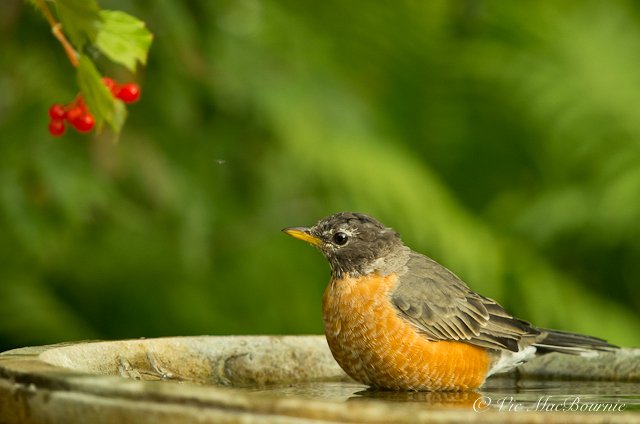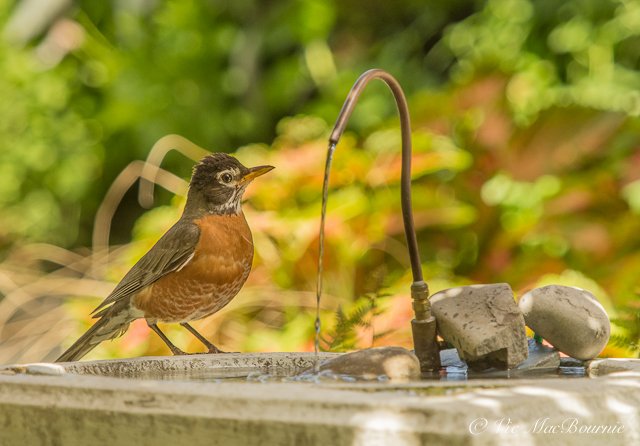American Robins: How to attract them to our yards
The American robin has always been a mainstay in our backyard whether they are eating crabapples or enjoying themselves in the bird bath.
More of these spring harbingers are remaining all winter
Most of us remember the first sign of spring involved an orange breasted bird and a worm.
Once we saw our first Robin pulling a worm out of the grass it was officially spring. Today, many of those same orange breasted birds are sticking around all winter living off berries, bugs, larvae and anything else they can scrounge to get them through our winters.
Milder winters resulting from climate change are certainly playing a role in more American Robins remaining in their northerly limits, but the threat of sudden and prolonged periods of freezing temperatures combined with heavy snow fall can certainly put the birds in severe danger.
It’s another good reason to ensure we do our best to supplement our bird feeders with more natural food for the birds – berries, fruit and even meal worms – especially during the winter.
Be sure to check out my comprehensive post on the best plants to feed birds naturally and save money.
Robins are regulars in our backyard
Throughout most of the winter, I watch a small flock of American Robins feeding off of our two crabapple trees in the back of the yard. I suspect it is an important food source for the resident Robins, when other food supplies in the area are scarce.
The American Robin is probably one of the most familiar birds in North America. In fact, it is actually the state bird of three northeastern states – Connecticut, Michigan and Wisconsin.
Where did the American Robin gets its name?
The American Robin got its name from European settlers who named it after the more diminutive and cheerful European Robin, which sports an equally impressive red breast and is often referred to as “Robin Redbreast.”
Although it is easy to see that the colouring of the two birds resulted in the identical names, the similarities more or less end there.
The American robin is actually a member of the thrush family and is much larger than its European namesake. Those who have studied the history, say that the two birds were given the same name as much for their character as their colourings. Both birds readily adapt to urban areas and are happy to live among humans, in fact, they eagerly stay close by to benefit from potential insects we sometimes stir up in the garden.
Whether you are in England digging a new garden bed or New York, chances are a robin is nearby watching your every move. And, don’t be surprised if they come right down to your feet to nab an unearthed worm or other insect.
It turns out the European settlers didn’t stop giving North American birds the Robin moniker after bestowing it upon the American Robin. Apparently, even our beloved bluebirds were tagged with the name robin. That’s understandable since the Eastern bluebird sports a lovely orange breast and reflects many of the traits of the European robin when it comes to size and characteristics.
But that didn’t end the Europeans obsession with naming our birds after their beloved robins. Towhees originally earned the name ground robin and Baltimore Orioles were called the Golden Robin.
Obviously all four sport red-orange breasts that undoubtedly played a role in being compared to the friendly European robin, a mainstay in any British garden.
In fact, the American robin in all but colouring, is more related and shares more things in common to the Eurasian blackbird. Other than its colouring –which is all black – the blackbird is also in the thrush family and sports similarly to the American robin, a yellow beak and white around its eye.
Early Americans also called the bird the wandering thrush, which seems a more accurate description.
Robins love a good bath
If there is one thing in our garden that the robins love most, it’s our many bird baths sprinkled about. if you are looking to attract Robins to your yard, a couple of good, solid, large bird baths are essential. You will be amply rewarded, if you can keep a good reliable source of water for them throughout the winter.
Be sure to check out my article on creating a DIY heated bird bath for the winter.
American Robin is actually a woodland bird
Although the birds are a common sight in residential yards and parks, this wasn’t always the case. American Robins are actually woodland or forest dwelling birds that have learned to adapt to the abundance of food – primarily worms in grass – in surburban landscapes.
Many of our American Robins end up returning to woodlands and more “wild” areas in the winter,where they can more easily find food – in an abundance of berries and other fruit as well as overwintering insects and larvae.
Creating a more natural yard, by planting plenty of native berries as well as leaving leaf litter for overwintering insects and larvae, will help to attract these wonderful birds throughout the winter.
Creating this natural food source in your woodland/wildlife garden will also go a long way to ensure the survival of the American Robin in your neighbourhood.
Robins love their bird baths. Be sure to ad a birdbath or small pond to attract these members of the Thrush family.
How do Robins survive winter?
During the winter, it is common to see the Robins travelling in large flocks where they work together to find natural food sources. Winter roosts can be huge with some estimates reaching more than two hundred thousand birds.
But, just because you see flocks of Robins in your area one year, does not mean they will necessarily return the following year.
Robins tend to be nomadic birds that don’t follow the typical north to south migration route. Individual Robins get around and may winter in completely different geographic areas from one winter to another. They have been known to travel long distances between states following the abundance of food in any given year.
Each spring, however, Robins return to their original nesting area and have even been known to use the previous year’s nest – with some modern improvements of course – if it proved successful the previous year.
A few facts about Robins
• In more northern regions of Ontario for example, Robins continue to be known as the harbingers of spring. They tend to show up around the end of March through early April as the warmer weather thaws the ground making worms and other insects more accessible.
• Worms only make up 15-20 per cent of the Robin’s summer diet. The rest is made up of other insects, fruits and berries.
•Robins tend to eat more earth worms in the early morning when they are more visible and closer to the surface, and turn to fruit later in the day.
• Robins belong to the Thrush family – family of birds known for their beautiful songs. Because Robins tend to hang out in neighbourhoods and around other human-dominated habitats, their spring songs are very familiar to most of us wheter we know it or not. Their rich, cheerful songs fill our neighbourhood each spring when they are particularly vocal announcing the arrival of spring and their readiness to mate and get on with building their families. Robins are known to sing their songs throughout the day and even will after sunset.
• Because Robins are comfortable in our gardens and around humans, it is not uncommon to have a pair nesting close to our homes and high-traffic areas such as on top of exterior lights, in hanging baskets on garden ornaments or just about anywhere the pair can find a good sturdy structure to build their nest. Last year, our neighbours had a pair nesting in a wreath near their front door, seemingly oblivious to all the comings and goings.
The birds’ ease around us often provides excellent opportunities to observe the family as they grow up in front of our eyes.
They can be the perfect opportunity for children to be exposed to the beauty of nature as they watch the parents on the nest, feeding the young and eventually watch as the fledglings leave the nest.
If you have children or grandchildren who express an interest in nature, be sure to check out my comprehensive post about why children need more nature in their lives.
Robins can nest up to three times in a breeding season, often using the same nest. However only about 40 per cent of the nests produce young and only about 25 per cent of those young Robins survive through fall to take on the winter. About half of the Robins that go into winter survive to mate the following spring.
Given those statistics, it’s not surprising that American Robins have an average lifespan of about 1.5 to two years, but they can live longer if given the right environment. For example, the longest lived American Robin recorded in the wild was almost 14 years old.
How to identify the American Robin
The American Robin is one of the easiest birds to identify with their rusty red belly against a greyish-black upper body, a bright yellow beak and white markings around their eyes.
These rather large birds measure around 25 centimeters long and weigh in at 77 grams, making them the largest thrush in North America.
The can be found right across North America from the farthest reaches of Alaska in the north, across to Canada’s Newfoundland and down south from Florida across to California.
Are American Robins threatened?
Robins face a hose of deadly foes around our residential gardens from the over use of insecticides especially on turf grass where they feed on worms and other insects, to the presence of unnatural predators such as cats, and collisions with windows.
Be sure to check out my two earlier posts on protecting birds from stray cats and how to protect birds from window strikes.
A more serious threat that has recently attacked American Robins is the mosquito-born virus West Nile that has killed a stunning number of both Robins and Blue Jays.
Be sure to check out this link for my comprehensive post on Blue Jays and West Nile.
Despite these challenges, the good news is that studies are showing that the American robin populations over the past 40 years have slowly increased. This increase is thought to be related to their ability to adapt their lifestyle to live comfortably in our suburban neighbourhoods.
The combination of a more readily accessible food source (worms), safe nesting places (unnatural as many of them are) and milder winters have no doubt combined to provide American robins with a fabourable environment despite the many threats they face in the suburban landscape.






